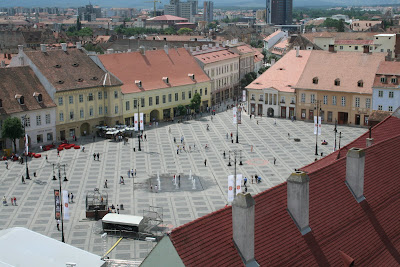
Peles Castle
King Carol I of Romania (1839-1914), one of the great Romanian kings and conqueror of the National Independence, first visited the region and future site of the castle in 1866, when he fell in love with the rugged but magnificent mountain scenery. So, in 1872, a total of one thousand "pogoane", approx. 1,300 acres (5.3 km2), is purchased by the king and Piatra Arsa region becomes The Royal Domain of Sinaia, destined to be a hunting preserve and summer retreat for the monarch. On August 22, 1875, the foundation for Peleş Castle, the city of Sinaia, and indeed for the country of Romania itself was established. Several other buildings, annexed to the castle, were built simultaneously: The Guard's Chambers, The Economat Building, The Foişor Hunting Chateau, The Royal Stables. The Power Plant was also constructed then, and Peleş became world's first castle fully operated by electric power. The "Sipot" Villa was constructed later. This would serve as the work site of architect Karel Liman. Liman would later supervise the building of Pelisor chateau (1889-1903, the future residence of King Ferdinand and Queen Marie of Romania), as well as of the King's Ferdinand Vila in the Royal Sheepfold Meadow (the actual Sheepfold Meadow). First three initial design plans for Peleş were copies of other palaces from western Europe but king Carol I rejected them all as they were too costly and unoriginal. Second architect, Johannes Schultz won by presenting a more original plan, something that appealed to the king's taste: a grand palatial alpine villa combining different structures of classic European styles, mostly following Italian elegance and German aesthetics in Renaissance lines. The cost of the castle itself between 1875 and 1914 was estimated to be 16 000 000 gold Romanian lei (approx. $US 120 million today). Between three and four hundred men worked consistently on it. QueenElisabeth of Romania, during the construction phase, wrote on her journal:
Italians were masons, Romanians were building terraces, the Gypsies were coolies. Albanians and Greeks worked in stone, Germans and Hungarians were carpenters. Turks were burning brick. Engineers were Polish and the stone carvers were Czech. The Frenchmen were drawing, the Englishmen were measuring, and so was then when you could see hundreds of national costumes and fourteen languages in which they spoke, sang, cursed and quarreled on all dialects and tones, a joyful mix of men, horses, cart oxen and domestic buffaloes.
Construction has seen a slight halt during the Romanian War of Independence in 1877-78, but soon afterwards plans grew in size and growth was rapid. Peleş Castle has seen its official Royal Ball of inauguration in 7 Oct. 1883. Until the castle was built, King Carol I and Queen Elizabeth lived in Foişor Villa (where King Ferdinand and Queen Mary also resided during the construction of Pelişor Castle). Even King Carol II lived in Foişor Villa when he was King of Romania (1930-40, except in 1932-3 when the hunting house was destroyed by fire). King Carol II of Romania was born at the castle in 1893, giving meaning to the phrase "craddle of the dinasty, cradle of the nation" that Carol I bestowed upon the Peleş Castle.
After King Michael's forced abdication in 1947, the Communist regime seized all royal property, the whole Peleş complex except the homonymous castle which was opened for tourism became, for a short time, a creation and resting place for Romanian cultural personalities. The castle was declared a museum in 1953. During the last years of the communist regime, between 1975-1990, Nicolae Ceausescu closed the entire area. The only persons accepted in this area were maintenance and military guard personnel. The whole area was declared a state protocol interest area.
It is interesting to note that Ceauşescu did not like the castle very much and visited rarely. According to some that is due to the wicked resident museographers, whom , counting on Ceausescu couple's paranoid health phobias, declared the building is infested with dangerous fungus Serpula lacrymans, whom, in 1980s was true to a certain extent but was only affecting the timber. After the December 1989 Revolution, Peleş and Pelişor Castles were re-integrated into the tourism circuit. At this moment, The Foişor Castle remains - like in the past times - a presidential residence, unlike the Economat Building and the Guard's Chambers Building where hotels, restaurants and terraces have been established. The other components of Peleş complex became either tourism villas or state protocol buildings. In 2006, the Romanian government announced restitution of the castle to king Michael I of Romania. Soon after re-obtaining the title, negotiations begun and Peleş re-became national treasure open to public as historic monument and museum.
In exchange the Romanian Government granted 30 million euros to the Casa Regala (The Royal House of Romania). The sum for the remaining villas and surrounding chalets and chateaus are still being negotiated but will eventually remain in possession of the state and touristic circuit after repurchasing (2007). Every year since opening, Peleş Castle received between a quarter to almost half million visitors every year.
Peleş Castle was host to grand figures guests from royalty and politicians to artists. One of the most memorable visits was that of Kaizer Franz Joseph I of Austro-Hungary, then one of the world's most powerful men, on 2 October 1896, who later wrote in a letter: The Royal Castle amongst other monuments, surrounded by extremely pretty landscape with gardens built on terraces, all at the edge of dense forests. The castle itself is very impressive through the riches it has accumulated: old and new canvases, old furniture, weapons, all sort of curios, everything placed with good taste.









































